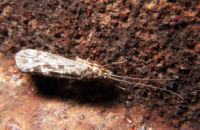
Photo from wikipedia
Abstract We report results from the first statewide assessment of biological health in perennial streams in Washington State. Using a probabilistic sampling survey design, we were able to make unbiased… Click to show full abstract
Abstract We report results from the first statewide assessment of biological health in perennial streams in Washington State. Using a probabilistic sampling survey design, we were able to make unbiased estimates of biological condition of macroinvertebrate communities throughout the state based on 346 sites sampled from 2009 to 2012. Results from randomly sampled sites were classified as either good, fair, poor in comparison with 75 regional reference sites that were sampled concurrently. We determined that approximately 34 percent of stream kilometers assessed were in poor biological condition as measured with a multi-metric index, the Benthic Index of Biotic Integrity. Additionally, we evaluated a variety of chemical and physical habitat stressors known to negatively influence macroinvertebrate communities and determined that poor substrate conditions were the most prevalent and important stressors impacting stream macroinvertebrates, with relative bed stability and percent sand/fines being the most prevalent. A relative risk/attributable risk analysis suggests that improving physical habitat conditions in streams, most notably a reduction in percent sand/fines, will have the greatest impact for improving biological condition for macroinvertebrate communities. It is estimated that approximately 60% of stream kilometers now classified as in poor biological condition in Washington could be improved by reducing the amount of percent sand/fines in the substrate. These results are consistent with those obtained from EPA’s national stream surveys and suggest that poor habitat conditions are the most prevalent stressors impacting stream macroinvertebrates in Washington State.
Journal Title: Ecological Indicators
Year Published: 2019
Link to full text (if available)
Share on Social Media: Sign Up to like & get
recommendations!